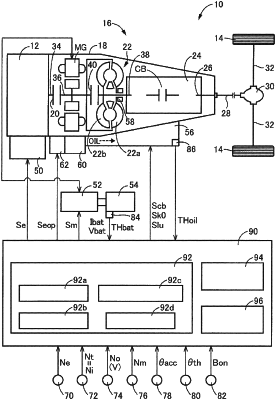| CPC B60W 20/40 (2013.01) [B60K 6/24 (2013.01); B60K 6/26 (2013.01); B60K 6/387 (2013.01); B60W 10/02 (2013.01); B60W 10/08 (2013.01); B60K 2006/268 (2013.01); B60W 2710/021 (2013.01); B60W 2710/083 (2013.01); B60Y 2200/92 (2013.01); B60Y 2400/46 (2013.01)] | 3 Claims |

|
1. A control device for a vehicle including an engine, an electric motor connected to a power transmission path between the engine and drive wheels so as to be able to transmit power, and a clutch provided between the engine and the electric motor in the power transmission path, a control state of the clutch configured to be switched by controlling a clutch actuator, the control device comprising an electronic control unit configured to:
perform, when the engine is started, a first clutch actuator control in which the clutch transmits a cranking torque for increasing a rotation speed of the engine during a transition in which the control state of the clutch is switched from a released state to an engaged state;
perform, when the engine is started, first control for outputting the cranking torque by the electric motor and second control for starting operation of the engine; and
perform, after the first clutch actuator control is completed, a second clutch actuator control in which a torque capacity of the clutch is set to a predetermined torque smaller than the cranking torque,
wherein the electronic control unit is configured to set the torque capacity of the clutch to a value larger than the cranking torque instead of executing the second clutch actuator control when a start of the engine is requested due to an increase in a drive request amount for the vehicle by a driver.
|